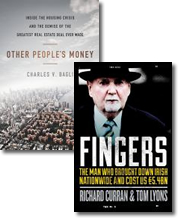Book Reviews: Bursting the Housing Bubble
 Lyons, Tom and Richard Curran. Fingers: the man who brought down Irish Nationwide and cost us €5.4bn. Gill & Macmillan, 2013.
Lyons, Tom and Richard Curran. Fingers: the man who brought down Irish Nationwide and cost us €5.4bn. Gill & Macmillan, 2013.
Bagli, Charles V. Other people’s money : inside the housing crisis and the demise of the greatest real estate deal ever made. Dutton, 2013. also available in audiobook format.
It has been 6 long years since the Great Recession began in 2008 and people are starting to ask how it happened that no Wall Street bankers were charged with crimes for their part in meltdown of the economy. Taxpayers are asking why they covered the losses of the powerful, while ordinary citizens who owed money lost all their assets. Two new books in the Ford Library describe the origins of two financial crises, one in Ireland and the other in New York City, explaining what went wrong and who is to blame.
In Fingers, business journalists Tom Lyons and Richard Curran tell the story of Michael Fingleton, self-made man, one-time billionaire and banking legend, who as head of the Irish Nationwide Building Society was responsible for the second largest failure in Irish history. The authors describe the greed and ambition of the CEO, as well as his autocratic style, effectively a one-man loan department. They explore the reasons for the society’s failure, including mismanagement and a troubled culture. They also expose how financial regulators knew about the problems at the bank for decades yet did nothing to induce change. In the end, the bank’s failure cost the Irish taxpayers 5.4 billion euros, while Fingers and his political friends walked away.
Similarly across the pond, New York Times journalist Charles Bagli explains in Other People’s Money how international real estate mega-firm Tishman Speyer Properties and its partner, BlackRock, lost $4 billion on a single deal financed with almost zero equity. Using this project as a lens into the housing bubble, Bagli explains that investors expected housing prices to rise perpetually while developers failed to anticipate resistance from established tenants. Wall Street banks loaned billions to the developers despite inadequate cash flow expectations because they rebundled the loans and sold them to investors. In the end, Tishman Speyer and BlackRock walked away from the property unscathed, while the investment losses by public employee retirement funds flowed down to city budgets and to individual retirement accounts.
Both books are clear first person accounts of titanic failures that explain the causes and consequences of the real estate bubble in the early 21st century. Both are recommended.
© Reviewer: Meg Trauner & Ford Library – Fuqua School of Business.
All rights reserved.